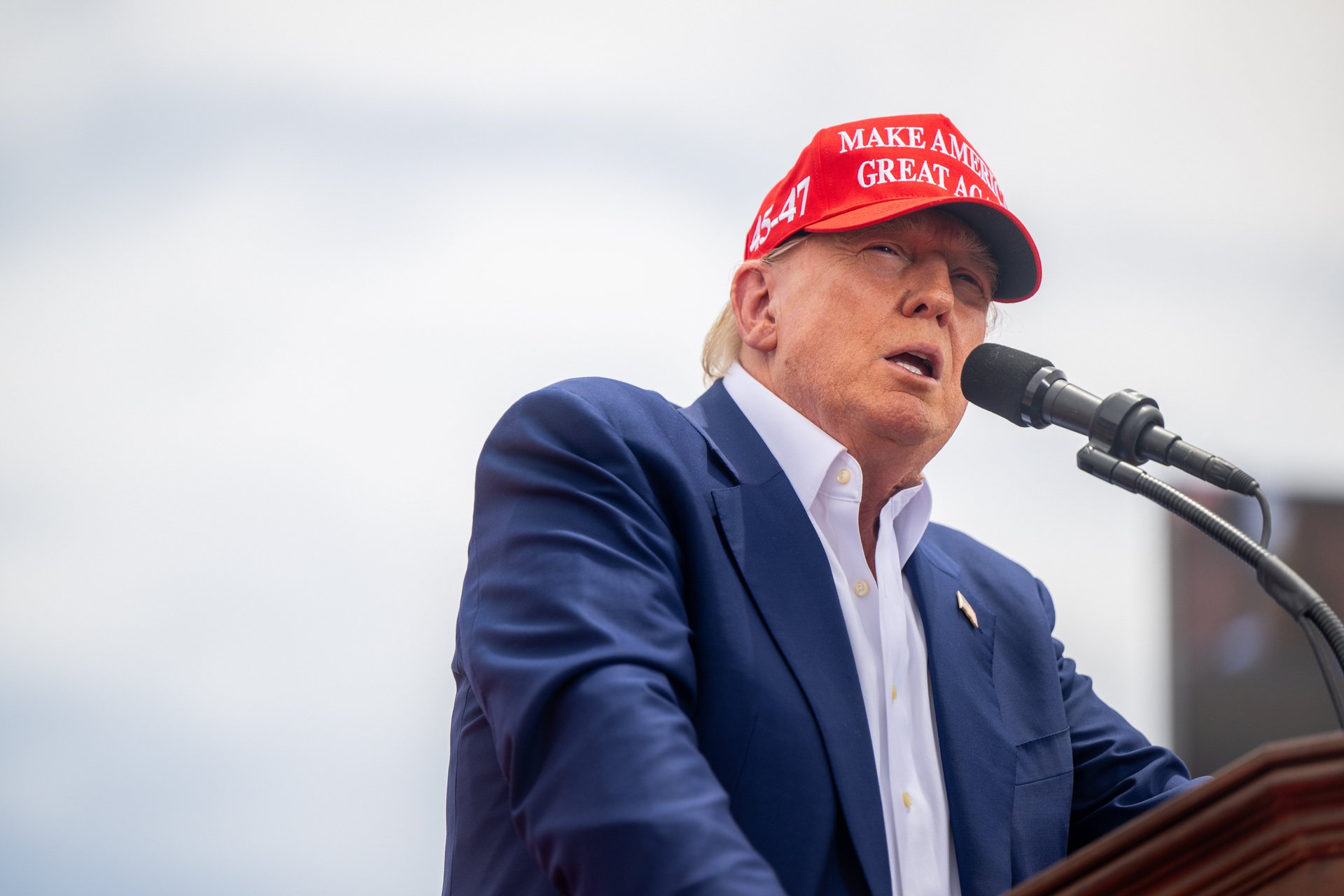
Donald Trump is wooing CEOs with promises of a 20% corporate tax rate
Top CEOs including JPMorgan's Jamie Dimon and Apple's Tim Cook were in attendance when Trump promised the tax cuts

Top CEOs including JPMorgan's Jamie Dimon and Apple's Tim Cook were in attendance when Trump promised the tax cuts
Presumptive Republican presidential nominee Donald Trump is wooing Wall Street and beyond with sweet talk of lower tax rates.
In a meeting with CEOs of the biggest U.S. companies on Thursday, Trump promised to cut the corporate tax rate to 20%, Bloomberg reports, citing unnamed sources familiar with the comments.
Major players in the U.S. economy, including JPMorgan Chase CEO Jamie Dimon, Apple chief Tim Cook, Citigroup’s Jane Fraser, and Bank of America’s Brian Moynihan, were among the approximately 100 attendees of the quarterly CEO meeting hosted by the Business Roundtable in Washington, D.C.
Such a tax cut would be a continuation of the first Trump administration’s Tax Cuts and Jobs Act of 2017, which slashed the tax rate from 35% to 21% — a massive reduction that was praised by CEOs across the board, including Dimon. But for corporations raking in billions of dollars each year, even a single percentage point decrease in tax rates means millions more in company coffers.
The Trump tax cuts, which went into effect on Jan. 1, 2018, are set to expire next year. In Thursday’s meeting, Trump vowed to make them permanent, and to renew tax cuts for individuals and small businesses, Bloomberg reports. He also promised to reduce business regulations if he is elected.
The Biden administration has taken a less corporate-friendly stance, particularly when it comes to taxation and perks for big businesses. In March, Biden unveiled plans to raise the corporate tax rate to 28% from its current 21%. The White House also has its sights set on an increase to the minimum tax rate on billion-dollar corporations, which would bring it from 15% to 21%.
The Biden administration’s push to make the ultra-wealthy pay their “fair share” also includes a proposed 25% percent minimum tax on the wealthiest 0.01% and raising the marginal income tax rate back to 39.6% for the top 1%.
White House Chief of Staff Jeff Zients spoke to the same group of executives prior to Trump’s “fireside chat,” Bloomberg reports. President Joe Biden was unable to attend the event due to the Group of 7 summit in Italy.
Zients told the CEOs that Biden remains committed to collaborating with the private sector on economic growth, and described some of the subsidies and infrastructure projects that are expected to deliver material impacts to corporations within the coming months and years, Bloomberg reports. He also drew a contrast between Biden and Trump in terms of America’s reputation and reliability on the world stage.
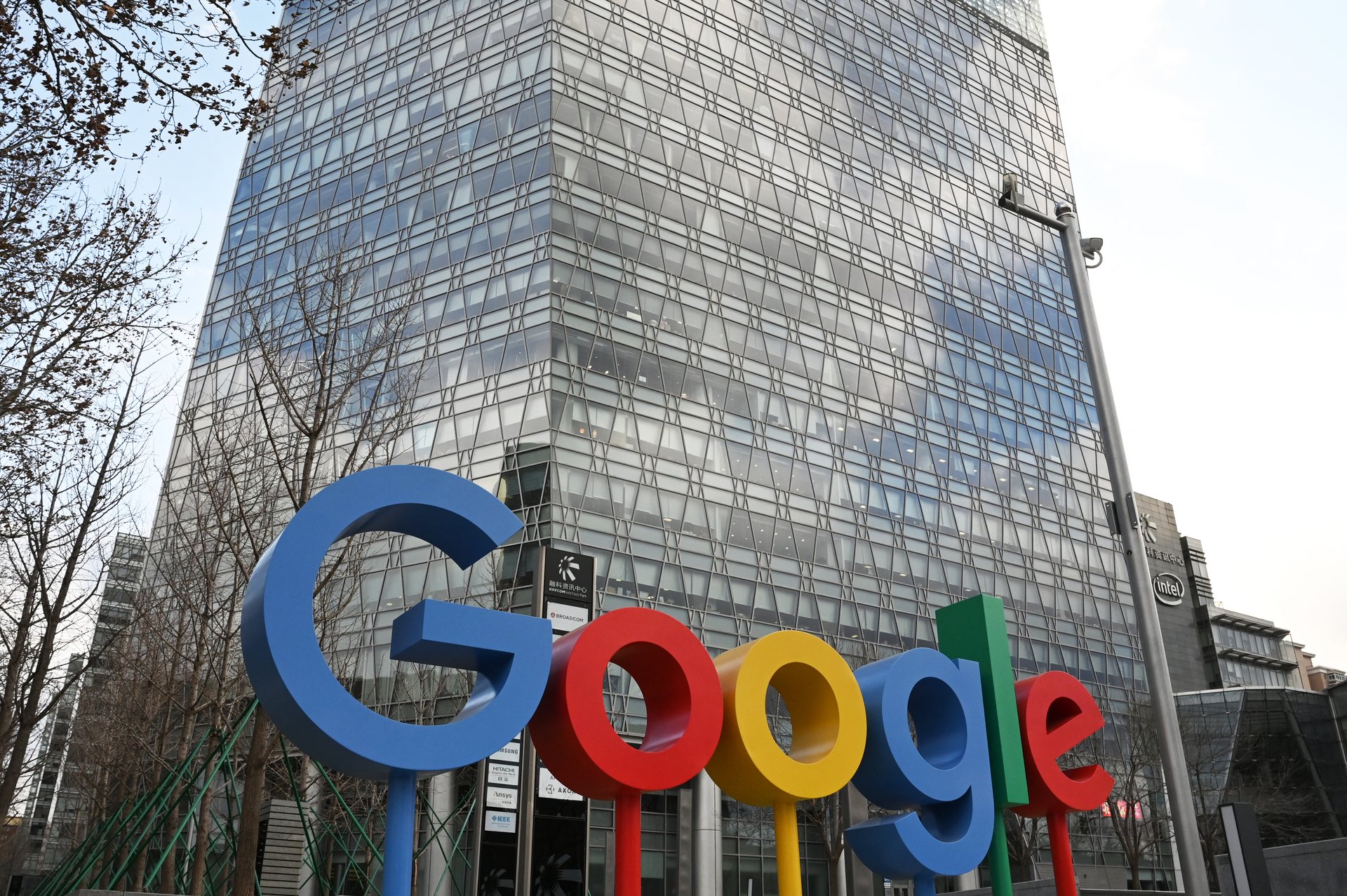
Good morning, Quartz readers!
Blurred trade lines. The U.S. and China may have reached a trade deal — or, at least, a trade framework — according to the president, but details are scarce.
China’s miner threat. China is reportedly leveraging a valuable asset in trade talks, subjecting U.S. companies to a six-month limit on rare earth minerals.
Cooler heads. Data from May’s CPI report showed that inflation cooled as the effects of the Trump administration’s tariffs remain limited — but the data was still below expectations.
No love for the Fed. President Donald Trump and Vice President JD Vance both bashed the central bank for not cutting interest rates amid the softening inflation data.
Banking on a bad turn? JPMorgan Chase CEO Jamie Dimon said he’s worried the economy could “deteriorate” soon — with employment coming down and inflation going up.
Takes two to tango. The feud between Trump and Elon Musk can be traced to… Argentina? Recently, the Latin American country has served as a far-right laboratory.
As the DOJ’s landmark antitrust case against Google nears a ruling, the company’s core search business is under threat — from regulators, yes, but perhaps more so from user behavior. Vineet Jain, CEO of Egnyte, recently ditched Google Search for four days and didn’t look back. His teenage son put it more bluntly: “We don’t use Google anymore. We use ChatGPT.”
It’s not just teen rebellion. Tools such as ChatGPT and Perplexity are chipping away at traditional search by skipping the blue links and delivering answers directly. According to a report from Mary Meeker, ChatGPT reached a billion daily queries in under two years — Google took over a decade. That shift threatens Google’s most valuable asset: not its algorithm, but its default status. In 2022, the company paid Apple over $20 billion to be the preset engine on Safari.
That’s what’s on trial. Judge Amit Mehta is weighing whether those exclusive distribution deals violate antitrust law. But even if Google prevails, its business model may still be on the clock. The ad revenue engine — $50.7 billion last quarter alone — relies on default-driven, high-intent search traffic. As users drift toward cleaner, ad-free AI alternatives, the foundation begins to wobble.
Google has tried to respond with AI Overviews and its Gemini suite, but the strategy is caught in a paradox: serve direct answers, but keep users clicking to monetize attention. It’s a far harder act than it sounds — especially when rivals aren’t bound by the same ad-based incentives.
The courts may not force a reckoning, but the market might. As generative AI redefines what search even means, Google’s greatest challenge may be navigating a future that no longer revolves around it. Quartz’s Shannon Carroll has more on why the real risk to Google isn’t legal — it’s behavioral.
Apple didn’t go especially big at this year’s WWDC. Instead, the company debuted “Liquid Glass,” a design language for iOS that sparked comparisons — charitable and not — to Windows Vista. Apple’s AI announcements, meanwhile, underwhelmed Wall Street. One analyst dubbed them “incremental at best.”
But the most consequential news may have arrived with little fanfare: Apple quietly opened up its Foundation Models framework to developers.
For the first time, Apple is giving third-party developers access to its on-device large language models — with as few as three lines of code. This marks a major shift for a company that has long guarded its core technologies like trade secrets. It could also change the AI playing field.
While Apple’s in-house models trail others in scale, the company’s strategy isn’t about being first — it’s about being everywhere. With a billion active iPhones and a robust developer ecosystem, Apple may be betting that its modest models, embedded across its vast hardware base, can deliver utility through sheer distribution. If developers build compelling features atop Apple’s tools, the company won’t need to outpace OpenAI — it just needs to outlast it.
The strategy is familiar. Apple didn’t invent smartphones, tablets, or watches — but it may have perfected them. By enabling AI at scale across its devices, Apple might not just catch up in AI, it could reframe the category entirely. Quartz’s Jackie Snow has more on the strategy behind the subdued keynote.
🌍 Investors are ditching U.S. equities in favor of overseas assets
👬 Musk is walking back “some” comments on Trump ahead of a key launch
🤑 Leaders at X have threatened to sue companies that aren’t spending
💸 Google is offering more employees buyouts as it ramps up its AI spending
🤖 The president’s AI czar says AI isn’t coming for people’s jobs
✈️ Trump’s nominee to lead the FAA says he’ll hold Boeing accountable
Our best wishes on a safe start to the day. Send any news, comments, and more to [email protected].
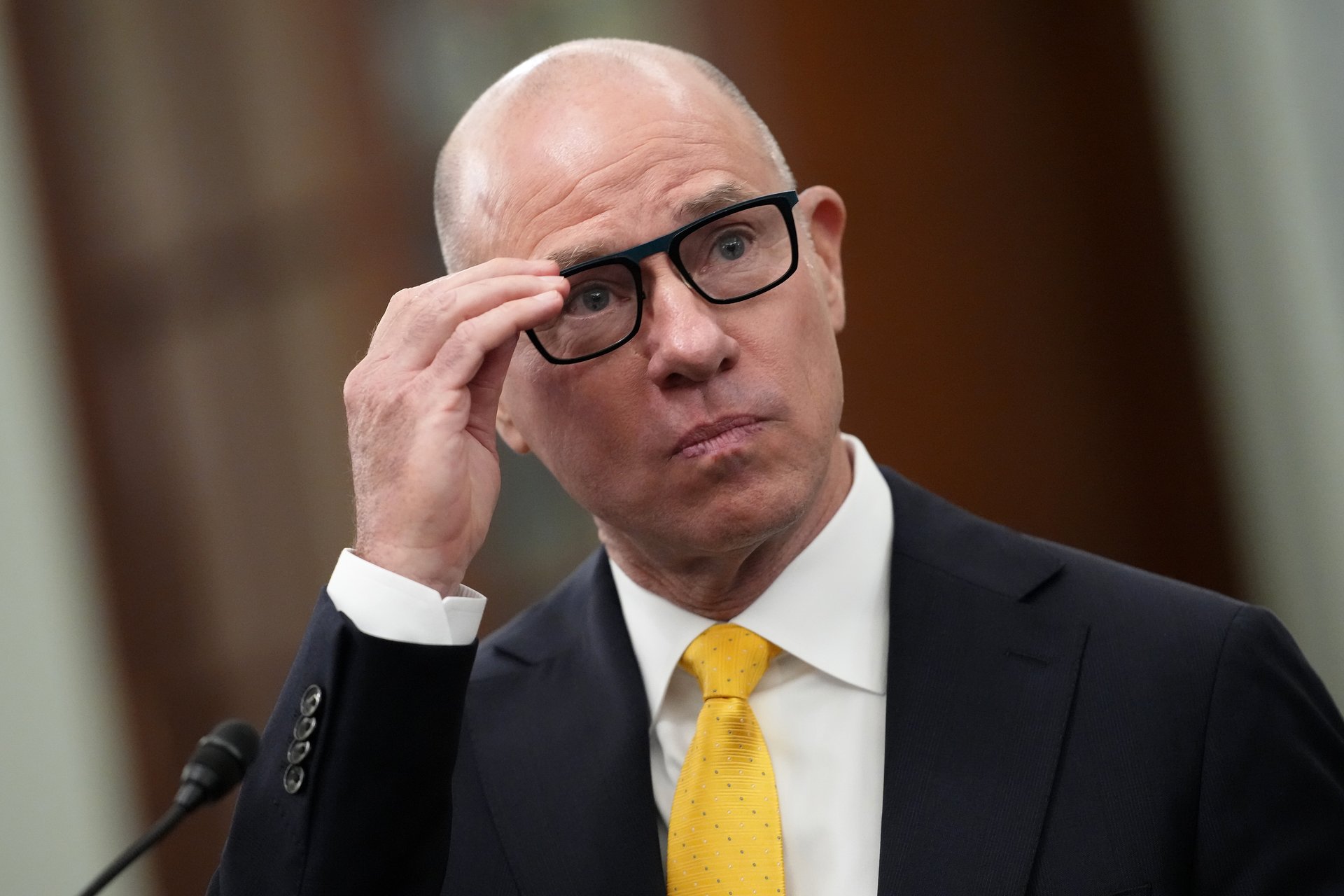
Bryan Bedford also says he was shocked by lack of leadership and ambition at the agency in wake of safety concerns
President Donald Trump's nominee to lead the FAA said Wednesday that he would hold Boeing "accountable to deliver a high-quality product safely,” as the plane maker continues to face the fallout from a string of sometimes deadly safety issues with its 737 Max jets.
Republic Airways CEO Bryan Bedford, who Trump has tapped to lead the Federal Aviation Administration, said during a Senate confirmation hearing that he would work with Boeing instead of just scolding it. Bedford said the FAA could tell Boeing “where the failures are” and “move the process along a little quicker.”
Boeing has been throttled by ongoing safety failures with planes, including accidents that killed 346 people in 2018 and 2019.
In May, Boeing said its new safety processes had streamlined to the point where they were consistently building 38 planes per month, as per an FAA-imposed cap after the Alaskan Airways incident of 2024, in which an emergency door blew open. Boeing had hoped to up that to 48 planes a month in a year’s time, but last week acting FAA administrator Chris Rocheleau said that was not going to happen any time soon. He did note, however, that Boeing had made improvements.
In advance of Bedford’s confirmation hearing, Reuters reported that he cited a “lack of steady and qualified leadership” at the FAA, which led to a “lack of any coherent strategy or vision.” Bedford argued that, "A malaise has set in whereby managers believe the agency is helpless to make the necessary changes, and furthermore, they rationalize it isn’t really their fault."
At the hearing itself, Bedford said that he had asked FAA employees what their goals were and said he was shocked to hear them answer that “they don’t have any."
The FAA’s biggest current challenge is the crisis in air traffic control, leading to incidents like the January collision near Washington Reagan Airport or the recent outages at Newark Liberty International Airport.
Rocheleau said the entire system needs an overhaul, citing the fact that many facilities—some of which are more than 50 years old—still use floppy disks and paper strips. Bedford says that when he asked FAA employees how the system could change, they merely answered that they would work harder. "That's just not the kind of leadership that we're going to need in order to get the job done," he told the hearing.

Fledgling companies are rewriting the rules of retail as they use AI to meet shoppers where they — and their wallets — are
Imagine opening your closet — except it isn’t a closet at all. It’s an app. One that knows your exact measurements, your plans, and your tendency to panic-buy crop tops every May. The app doesn’t just show you what’s trending; it tells you what still fits, what’s collecting dust in the back of your wardrobe, and what goes with that skirt you impulse-bought three years ago and never wore. Your digital closet is fully synced — color-matched, size-verified, and AI-organized.
You can swipe through outfit options on a 3D avatar of you while the app checks shipping speeds and resale prices on items curated for you by an AI that has been quietly learning your style since your first Depop binge.
This isn’t fashion’s sci-fi fantasy. This could be retail in the 2030s, where shopping is no longer a chore but a personalized stream of suggestions, swaps, and style edits fed by AI, filtered through popular culture, and executed by machines that don’t just know your inseam — they know your vibe. Shopping will be less browsing, more briefing: “You’re going to brunch on Saturday, 74 degrees, al fresco. That lavender top you forgot you own? Pair it with the white trousers that you don’t need to rebuy.” Your entire wardrobe: searchable, shoppable, and style-checked by something smarter (and less passive-aggressive) than your best friend.
All sorts of research shows that shoppers, especially among Gen Z, are buying on their phones, where they demand personalization, advice, and sustainable, reasonably priced options. Two startups — Phia and NewGen — show where shopping is heading.
Phoebe Gates (yes, as in that Gates family — she’s Bill’s daughter) and Sophia Kianni didn’t set out to disrupt retail. They just wanted to stop wasting hours hunting for the perfect outfit at the perfect price. Roommates at Stanford, the two bonded over a shared frustration: the endless, exhausting game of comparing prices across sites, scribbling hacks in notes tabs, and tracking sales like professional detectives. They quickly realized they weren’t alone.
“Time and time again, as we talked to other girls, we realized that pretty much every single girl who’s a power shopper has faced this exact same issue,” Gates says.
Their solution: Phia, an AI-powered browser extension that works while you browse, scanning over 40,000 websites to find better deals — on both new and secondhand items — without forcing you to change how you shop. “You don’t need to have a new app that you check every single day,” Kianni says. “We just pop up and do that little price check for you.”
Companies such as Klarna, Karma, and PayPal’s Honey are already automating the hunt for discounts and surfacing better options. But while Honey leans into coupons and cash-back and Klarna offers flexible payment options and curated drops, Phia aims to go further, positioning itself as a kind of savvy shopping assistant.
The broader trend is clear: Consumers increasingly expect their devices to do the heavy lifting.
According to a 2022 report from McKinsey, nearly 70% of consumers expect companies to personalize their interactions, and 76% get frustrated when that doesn’t happen. Browser-based tools are becoming key players in delivering that experience — not by reinventing retail, but by reshaping how discovery happens.
Phia allows users to set personal alerts — for example, “Let me know if this $500 coat drops below $300,” or, “Alert me if a secondhand version under $200 pops up.” Phia’s browser extension is part of a broader AI-powered personalization wave sweeping the retail industry: A 2025 Apply Digital report found that 95% of retailers are using or plan to use real-time product recommendations powered by AI, while 93% are exploring AI-enhanced search and 88% are testing dynamic pricing based on user behavior.
Phia’s founders see a bigger opportunity than just saving time or money. Retail, especially fashion tech, has remained largely stagnant — and that might be no accident. “Shopping and fashion hasn’t fundamentally been innovated in and disrupted in years,” Kianni says. “And I think it’s partially because this intersection of fashion and tech has just been neglected because a lot of the players in this space, quite frankly, are men.”
Gates notes that shoppers can order toilet paper from Amazon and have it arrive in under an hour, but there haven’t been many advancements when it comes to luxury e-commerce sites. That disconnect — between who shops and who builds the tools — is a gap Phia aims to close. “We are really excited to be young women who actually, genuinely love shopping and love shopping smart and love shopping secondhand, to be able to really innovate,” Kianni says.
Secondhand shopping, in particular, isn’t just a passion — it’s part of their pitch. Gates notes that buying secondhand can reduce an item’s carbon footprint by 80%, echoing data from a ThredUp report from 2021. Phia’s ability to align sustainability with cost consciousness hits a sweet spot for Gen Z.
Gates and Kianni are building the New York–based Phia with an eye toward shoppers who don’t browse the way previous generations did. “Younger consumers, especially Gen Z, they’re very mobile-first,” Gates says. “They’ll look at maybe two product pages before deciding whether or not to make a purchase.” That means there’s no room for slow-loading extensions, complicated dashboards, or greenwashed fluff. Phia surfaces the relevant details — resale options, sustainability flags, better prices — without changing how users shop.
For Gates, that means using Phia to find Yves Saint Laurent blazers for around $100, while Kianni likes to use the browser extension to get designer heels secondhand.
Phia isn’t the only tool chasing this future, but it’s part of a growing category of AI-powered services reshaping how people approach shopping. The old image of leisurely window-shopping is being replaced by recommendation engines, dynamic pricing models, and increasingly agentic AI systems — tools that don’t just respond to what users say, but anticipate what they’ll want.
For today’s busy, budget-conscious, increasingly tech-savvy shoppers, the algorithm isn’t intrusive. It’s overdue.
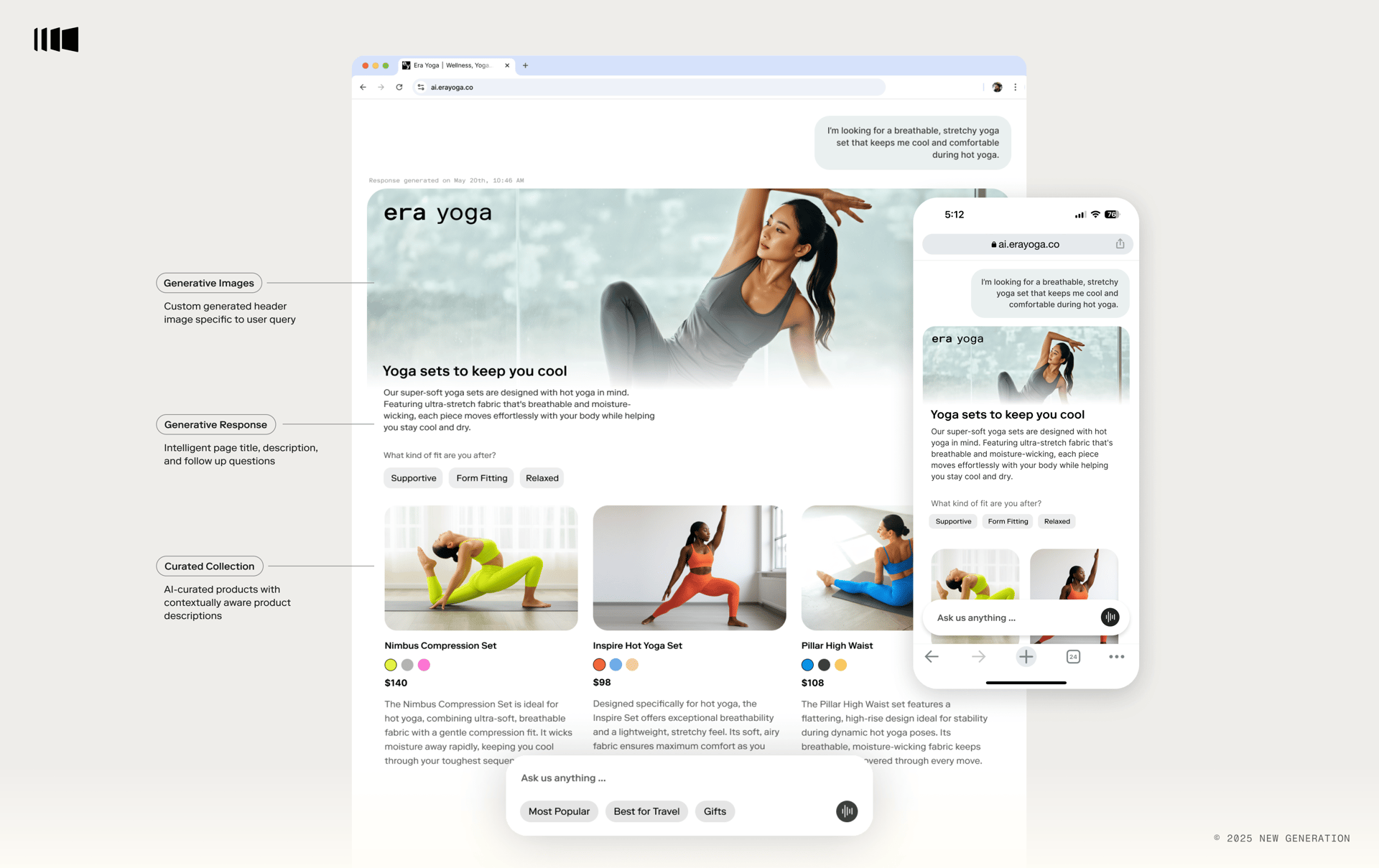
(Page mock-up via New Gen)
If Phia exemplifies the face of the new shopping interface, New Gen is the backend infrastructure with a developer’s brain and a retailer’s instinct. Where Phia aims to be your AI-powered shopping BFF, New Gen is building the storefronts that AI agents will pull from. The platform isn’t just about recommending bike shorts — it’s about making sure a company’s bike shorts show up with data and a generative, brand-controlled AI answer interface when you ask for them.
“Traditional retail websites weren’t designed for the conversational, AI-first future,” says New Gen co-founder Jonathan Arena. “We’re solving this by creating AI-native storefronts that deliver instant answers and visual, generative experiences without forcing shoppers through rigid navigation or filters.”
San Francisco–based New Gen gives each brand a dedicated, AI-optimized subdomain — think: ai.yourbrand.com — that acts as a dual gateway: Humans see a personalized, conversational experience, while AI agents get structured access to clean, enriched product data. Arena and fellow co-founder Adam Behrens are redesigning commerce for what they call the “AI internet.”
“Commerce is entering a conversational, AI-driven era where customers expect direct answers, not a scavenger hunt,” says Behrens. “Just as programmatic advertising replaced static banners, AI is fundamentally reshaping discovery and purchasing.”
Arena adds that in five years, retail brands are going to look more like software companies because of the programmatic internet. “They’re going to need to adapt this technology, understand how it works, control it, deploy it at scale, release updates,” he says.
In other words, the long-established sales funnel is dead, and in its place are apps and algorithms.
Gen Zers aren’t just adapting to AI — they’re the reason it’s accelerating across fashion and retail. These mobile-native shoppers don’t browse sites; they ask, scroll, and buy instantly via video, chat, and personalization tools that reflect their values. They demand speed, relevance, and sustainability at every step, and their behavior is already rewriting retail’s playbook.
The data bears this out. A 2024 report from Morning Consult found that 67% of Gen Z shoppers made an online purchase in the past year, the highest rate among all generations. This generation is also highly conscious of sustainability: NielsenIQ found that 73% of Gen Z shoppers are willing to pay a premium for sustainable products. Influencer recommendations heavily sway their buying decisions, as well: 58% have bought products endorsed by social media influencers, according to Global Web Index.
Perhaps most importantly, according to studies by Accenture and IBM, nearly 90% of Gen Z shoppers believe AI will improve their online shopping experience, and 59% expect AI to make shopping more personalized overall.
Retailers are racing to meet these expectations.
Research from Apply Digital in 2025 shows that nearly three-quarters of retailers have already embraced AI to tailor and enhance customer experiences at scale. A striking 95% are either already using or planning to deploy AI-powered real-time product recommendations soon. These shifts reveal a wholesale pivot toward dynamic, behavior-driven personalization — from product discovery through checkout — with the aim of meeting customer expectations instantly and seamlessly.
For companies like Phia and New Gen, Gen Z isn’t just the target demo — they’re the architects of what’s next. The future of shopping won’t be found in a mall or on a homepage. It’ll live in a browser extension, an AI chat, or an avatar’s closet — powered by data, optimized by programs, and styled to your scroll.
The mall is dead. Long live the algorithm.
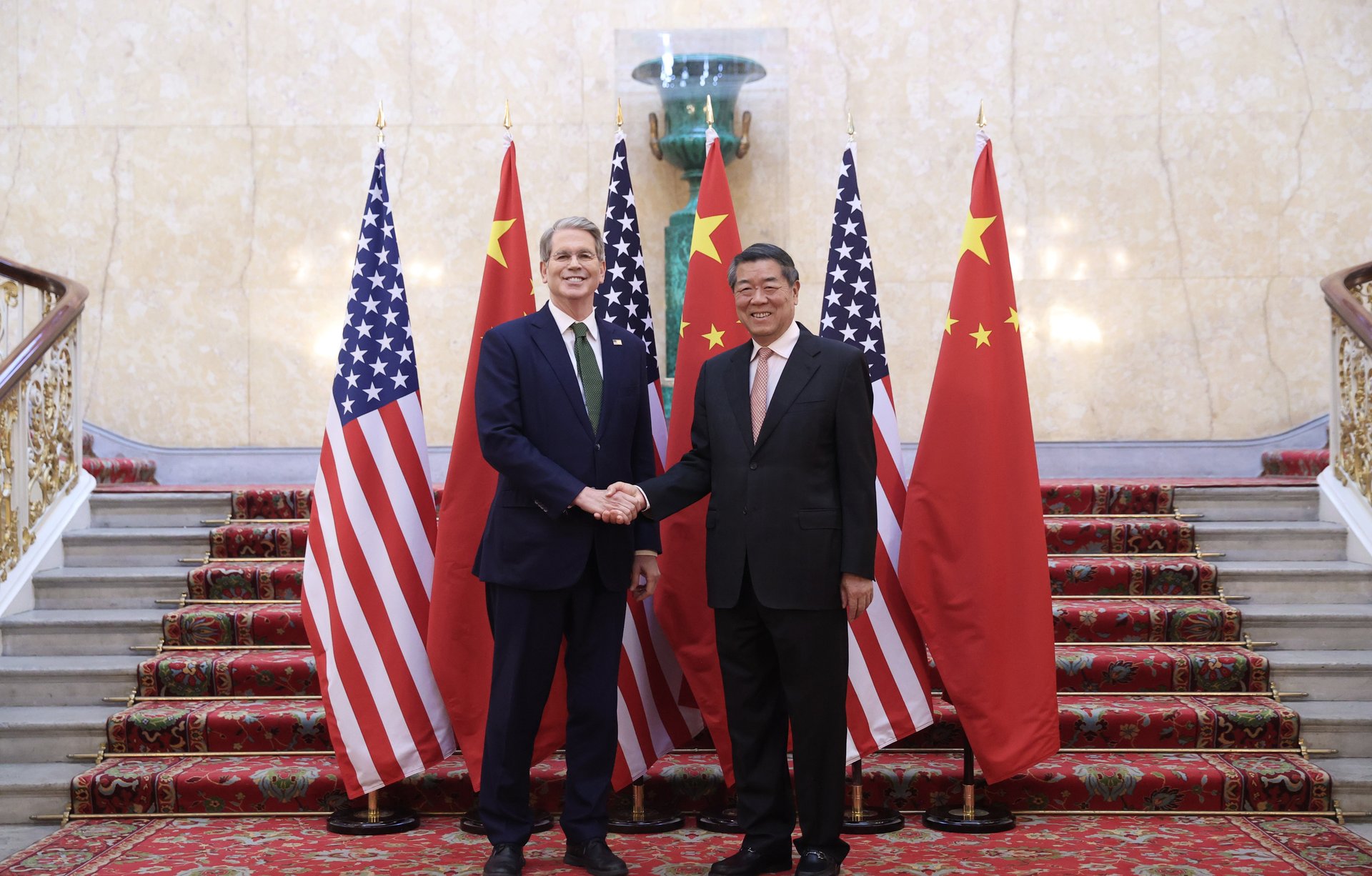
Beijing is holding on to a valuable bargaining chip, despite reaching an agreement on US-China trade.
China is subjecting U.S. automakers and manufacturers to a six-month limit on rare-earth export licenses, sources familiar with the matter told The Wall Street Journal on Wednesday.
The aim is to give Beijing leverage should its trade war with Washington escalate again, while amplifying uncertainty for American businesses, sources say.
Beijing had agreed to temporarily restore the licenses during trade talks with the U.S. negotiators in London this week, which was deemed to be a major breakthrough of the meeting. Yet, the six-month limit suggests that there's still a desire to keep hold of bargaining chips. Beijing knows its grip on the supply of critical minerals is a valuable weapon for future negotiations, sources said.
In return for reinstating the licenses, the U.S. has agreed to ease some restrictions on exports to China, sources said. These include jet engines and related parts, and ethane, a chemical used for manufacturing plastics. China has agreed to start approving U.S. companies’ license applications imminently, contingent on President Donald Trump and Chinese leader Xi Jinping’s approval of the trade framework, sources said. At that point, the U.S. will also begin to drop the export controls on the jet engines and ethane, they added.
The White House could not be immediately reached for comment.
The London talks have finalized a trade framework which was only agreed "in principal" during the US-China trade talks in Geneva, Switzerland, on May 11 and 12. Trump said in a Truth Social post on Wednesday: “Our deal with China is done." Treasury Secretary Scott Bessent led the American delegation in the talks with Chinese Vice Premier He Lifeng.
The Geneva meeting took place with the aim of defusing tensions and easing export restrictions that threaten global manufacturing.
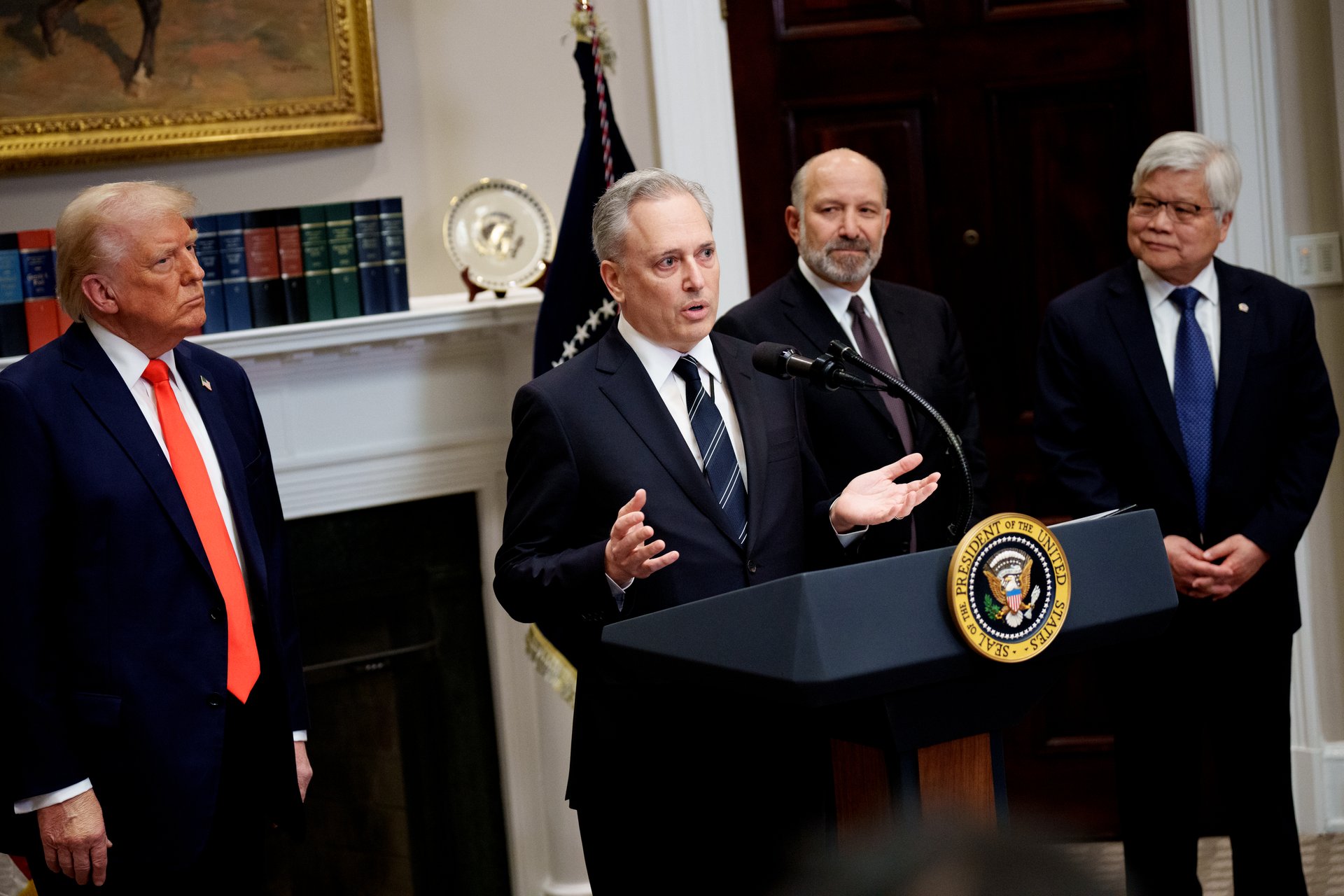
The Trump administration official thinks people will learn to work with AI — and trying to stem its rise is "like telling the tides to stop"
One top Trump administration official thinks that the losers in the AI arms race may not be the ones replaced by machines — but the ones outpaced by colleagues who know how to use the machines better.
David Sacks, the tech investor tapped by President Donald Trump to shape AI policy, says Americans are focusing on the wrong threat. Sacks downplayed predictions of mass job loss in favor of a more optimistic — if demanding — future of work. Speaking publicly on Tuesday, Sacks said he doesn’t believe AI will trigger widespread unemployment. Instead, he framed the technology as a multiplier for human productivity, echoing historic shifts in labor.
“You’re not going to lose your job to AI,” he said at a recent AWS Summit in Washington. “You’re going to lose your job to someone who knows how to do AI better.”
Sacks is betting AI won’t replace whole jobs but will instead automate routine pieces, letting workers get more done and add skills. That’s how past revolutions unfolded, he said: fewer farmers, not more long-term unemployed bodies.
“Personally, I don’t think [AI is] going to lead to a giant wave of unemployment,” he said, pushing back against what he called the “doomer cult” predicting mass job loss.
Sacks’ comments come at a time when prominent voices have warned about widespread disruption. Some studies foresee millions of displaced workers, and calls for universal basic income (UBI) are gaining traction. Anthropic CEO Dario Amodei said recently that AI could wipe out some white-collar jobs and drive unemployment to 20% — adding that tech leaders “have a duty to be honest about what’s coming.”
But Sacks seems to reject that narrative
“I think it’s actually very hard to replace a human job entirely,” he said. “I think it’s easier to replace pieces of it.” Sacks said AI agents will increasingly support workers, not supplant them. “They’re under the guidance of human workers who know how to use them to get more productive,” he said, describing a future where people use AI to extend what they can do.
“I could see AI driving our growth rate to something like 4 or 5%” he said. “I think you’re already seeing the beginning of an AI boom. I mean, I’m very optimistic that this will be a huge economic tailwind for us.”
The Trump administration official said resisting the technology is futile.
“It’s kind of like telling the tides to stop — it’s just not going to happen,” he said, urging policymakers and educators to embrace the shift rather than attempt to block it. He pointed to a recent example of a teacher who adapted her curriculum by allowing students to complete certain assignments using AI tools while reserving other tasks for traditional, tech-free evaluation.
That kind of hybrid approach, Sacks suggested, is the right way forward — an acknowledgment that AI is here to stay, and students need to be fluent in it without becoming dependent on it.
“I don’t think that the right thing to do here is to throw up a wall and just be so afraid of AI that we try to resist it,” he said. “We have to embrace that opportunity. We have to have our workers know how to use AI — be creative with it.”

Elon Musk and his X CEO threatened advertisers with lawsuits amid a 44% decline in ad revenue
X, the social media platform formerly known as Twitter, is leaning into a coercive new advertising strategy under Elon Musk and CEO Linda Yaccarino: pressure, threats, and lawsuits.
That’s the picture painted in a bombshell Wall Street Journal report published Wednesday. The report describes how Musk and Yaccarino led an aggressive campaign to rescue X’s declining ad business by threatening to sue companies that refused to spend money on the platform.
Verizon, which hadn’t advertised on X since 2022, pledged at least $10 million this year after receiving a legal threat. Ralph Lauren also agreed to return after being threatened with a lawsuit. In all, at least six companies rejoined the platform after similar pressure tactics, according to the report. Some deals included binding ad-spend commitments, while others included soft or non-binding targets struck under duress.
Behind the scenes, X lawyers reportedly warned advertisers they could be added to an ongoing lawsuit alleging an illegal ad boycott. X first filed that suit last August, targeting the World Federation of Advertisers and several major brands. Unilever, Amazon’s Twitch unit, and Lego were all among them. Some companies, including Unilever, were later dropped from the suit after signing new ad deals.
The campaign marks an extraordinary and punitive effort to revive the platform’s revenue. After Musk’s $44 billion takeover in late 2022, user engagement is reported to have sharply declined. Advertisers fled in droves amid chaos inside the company and loosened content moderation standards. Yaccarino, a former NBCUniversal ad executive, has been attempting to lure those advertisers back with brand-safety tools and new content deals, including NFL and NBA highlights. But the threats suggest serious desperation.
At one point, a lawyer for X demanded that Pinterest commit to its pre-Musk ad spend for two years — or be sued. Pinterest declined, having found that its ads were more effective when run in other venues. X then followed through on its legal threat, naming Pinterest in the complaint.
“Advertisers are understandably concerned about the litigious streak of Musk’s X interpreted by some as ‘invest with us, or else,’” Ruben Schreurs, CEO of ad consultancy Ebiquity, told the Journal.
Musk has made his contempt for advertiser pressure clear in public, too. In a November 2023 interview at the DealBook Summit, when asked about brands leaving the platform, he said, “If somebody’s going to try to blackmail me with advertising, blackmail me with money… go f—k yourself.”
Addressing Disney CEO Bob Iger directly, who was reportedly in the audience, Musk added: “Hey, Bob, go f—k yourself.”
X’s ad sales fell from $4.6 billion in 2022 to $2.6 billion last year, a 44% decrease, even as the larger ad industry grew by double digits over the same period. For their part, Meta, Google, YouTube, and Amazon all saw vast gains in ad spend over that period Pinterest and TikTok also saw ad spending grow significantly.
Even Snap, with its choppy track record, saw ad revenue climb between 2022 and 2025.
Though it’s recently ticked up, X’s ad revenue remains well below pre-Musk levels, per the Journal. Emarketer projects 2025 will bring the first annual ad growth since the takeover, though it’s also expected to remain below pre-Musk-takeover levels.
Meanwhile the backlash may just be getting started. Some ad agencies are now demanding legal immunity from future lawsuits before agreeing to spend on X.
X has refused.

Trump has been pushing Fed Chair Jerome Powell to cut interest rates for months
President Donald Trump is always happy to have an excuse to bash the Federal Reserve, and May’s soft inflation numbers from the Consumer Price Index (CPI) provided just such an occasion.
On Tuesday, Trump posted on Truth Social: “CPI JUST OUT. GREAT NUMBERS! FED SHOULD LOWER ONE FULL POINT. WOULD PAY MUCH LESS INTEREST ON DEBT COMING DUE. SO IMPORTANT!!!”
Vice President J.D. Vance agreed in his post on X. “The president has been saying this for a while, but it's even more clear: the refusal by the Fed to cut rates is monetary malpractice," he wrote.
Data from the Bureau of Labor Statistics showed that headline inflation rose 2.4% annually — up slightly from April’s 2.3%, but still below expectations. Month-over-month, prices climbed 0.1%, down from April’s 0.2% pace. Core inflation, a measure that excludes more volatile food and energy prices, also came in softer than expected.
May’s Consumer Price Index report is the first to reflect, at least partially, the shifting landscape following President Donald Trump’s April “Liberation Day” tariff blitz. While many of the most sweeping tariffs were paused for 90 days pending trade negotiations, baseline 10% duties remain in effect for most partners, and some industry-specific tariffs, including those on steel and aluminum, doubled to 50% as of early June.
Trump has been pushing for interest rate cuts since the start of his second term. In May, he called Federal Reserve Chair Jerome Powell a “fool who doesn’t have a clue,” after an announcement that interest rates would remain steady for the third month in a row—since Trump returned to office. By contrast, the Fed cut rates three times in late 2024. At the May announcement, Powell told reporters, “The economy itself is in solid shape,” before adding with a wink that was surely seen by Trump, “My gut tells me that uncertainty about the path of the economy is extremely elevated.”
Before Trump's re-election, the Harvard Kenndy School suggested that a new Trump administration might bring about the "end of the Federal Reserve as we know it."
-Catherine Baab contribut

Investors are ditching U.S. equities in favor of overseas assets as economic concerns grow
Investors are ditching U.S. equities in favor of overseas assets as concerns grow over fiscal policy, rising debt, and a possible recession.
Exchanged-traded funds (ETFs) and equity mutual funds based in the U.S. saw outflows of $24.7 billion in May, according to LSEG data cited by Reuters. That’s the largest monthly exodus in a year. Meanwhile, last month European funds recorded inflows of $21 billion, taking year-to-date inflows to $82.5 billion, the highest in four years.
Data for 292 emerging market equity ETFs revealed inflows of $3.6 billion last month, bringing this year’s total to $11.1 billion, according to Reuters.
The S&P 500 is up just 3% this year. By comparison, it had risen 14% by this time last year.
President Donald Trump’s reciprocal tariffs on imported goods, and his fiscal policy, have a lot to do with the flight, as it has eroded U.S. assets’ safe-haven reputation.
Since the unveiling of the levies on April 2, the U.S. dollar has shed about 5% of its value against a basket of foreign currencies. Concurrently, in the week or so following "Liberation Day," a U.S. government bond sell-off ensued, sending 10-year Treasury yields soaring more than 12%. Yields remain high, hovering around 4.45%, up from 4.16% the day before the tariff unveiling.
Adding to the bond market’s tariff-related jitters, last week Trump unveiled his “Big Beautiful Bill," which could add $2.4 trillion to the deficit over the next decade, according to the nonpartisan Congressional Budget Office.
Typically, the dollar and yields have moved in step with each other, as higher yields signal to investors that economic growth is to come, thus attracting inflows of foreign capital and strengthening the currency.
That relationship appears to be breaking down, as the correlation reached its lowest level in nearly three years in June, according to the Financial Times' analysis of LSEG data. It's thought that higher borrowing costs could reflect higher risk, as the government takes on more debt while tariffs threaten growth.

As Novo Nordisk faces outside scrutiny, it's making an $812 million bet on the next weight loss frontier
Novo Nordisk is diving deeper into the AI drug discovery race, making a big bet on the future of weight loss drugs — just as investors might be beginning to question who (and what) is steering the ship. On Wednesday, the Danish pharmaceutical giant announced a deal worth up to $812 million with Deep Apple Therapeutics, a U.S.-based biotech startup that uses artificial intelligence to discover drugs.
The goal? To create an oral weight loss and heart health treatment that works differently from today’s blockbuster injections — such as Novo Nordisk’s Ozempic and Wegovy. Instead of targeting the popular GLP-1 pathway — the same mechanism behind Ozempic — Deep Apple’s approach aims at a different biological target, one that might avoid some of the side effects and supply issues that have dogged the current class of drugs.
On its face, the Deep Apple deal is a shot across the bow at Novo Nordisk’s rivals (such as Eli Lilly), which have chipped away at Novo Nordisk’s dominance in the $150 billion weight loss market. But timing is everything — the company is currently without a permanent CEO following the surprise departure of longtime CEO Lars Fruergaard Jørgensen in May.
And Novo Nordisk is dealing with fresh scrutiny from activist hedge fund Parvus Asset Management, which has quietly built a stake in the company and reportedly hopes to influence the CEO succession — a move that briefly lifted Novo Nordisk’s stock on speculation about boardroom shake‑ups.
All of that makes the Deep Apple partnership more than just another research deal or pipeline play. It’s a message to the market: Novo Nordisk wants to show it’s still at the forefront of the next wave of obesity treatments — even as the competition heats up and questions swirl around its direction and footing.
For Novo Nordisk, the deal is largely both a scientific and a strategic bet. Deep Apple’s tech combines AI, structural biology, and massive virtual libraries of potential drug compounds to search for new ways to treat disease — especially through so-called GPCR targets that are tricky but promising. If Deep Apple’s method works, it could help Novo Nordisk move beyond GLP-1 drugs and stay ahead of rivals.
Novo Nordisk has been on a partnership spree lately — inking deals with other biotech firms, most recently Septerna but also Omega Therapeutics, and Evotec. But the Deep Apple deal stands out for its size and its future-focused, AI-first approach. For Novo Nordisk investors, the deal with Deep Apple offers: a bet on scientific boldness and a statement that the company refuses to rest on the laurels of its GLP‑1 blockbusters.
The company’s stock is down over 29% in the last six months but is up 17% over the last month and 8% over the past five days.
Whether this deal works or not all comes down to execution. Developing pill-based treatments for obesity and heart-related issues is still risky and tricky. Once Deep Apple finishes the early research, Novo Nordisk will take over — and how fast they move, and whether or not the drugs actually work in early testing, will matter a lot. If all goes well, Novo could avoid problems such as fatigue with current treatments, supply issues, or cheaper copycat drugs.
If it doesn’t, the company risks deepening the doubts swirling around its leadership and long‑term strategy.
In many ways, the Deep Apple tie‑up is a test of faith — in the science and in whoever ends up steering the ship. As Novo moves to appoint a CEO (with some analysts speculating that a U.S. executive could help in the world’s largest weight‑loss market), and as Parvus observes from the wings, the stakes couldn’t be higher.